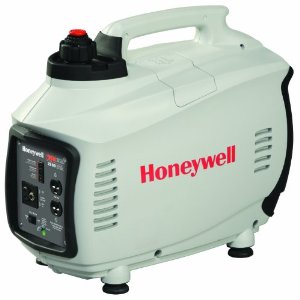One of the types of generators that seem to be becoming popular these days are the inverter generators. The hype around them comes from their ability to produce cleaner energy and electricity that is touted to be very stable and suitable to power up sensitive electronic equipments. But how does it really do this? This article will discuss the basic principles used by an inverter generator in producing the kind of energy that it claims to produce.
Honeywell 2000-6066 2,000 Watt 126cc 4-Stroke OHV Portable Gas Powered Inverter Generator
The only advantage that inverter generators is that they inherently have the capability to vary engine speed to match their load which is beneficial in terms of fuel consumption and efficiency. They accomplish this employing a 3-phase process in generating the output AC (alternating current) power. The first phase produces the expected AC power which is converted to DC (direct current) power in the second phase. The DC power is converted back to AC in the third and final phase. This final AC output is the current that is said to be what these types of generators are all about— clean and stable electricity for delicate electronics.
Many inverter type generators are smaller than their non-inverter counterparts. This is mainly due to the smaller yet powerful Neodymium magnets used by the engines as well as the innovative designs that manufacturers are continually coming up with.
Inverter generators are pretty popular in the portable generator segment that are designed for recreational use. Their variable engine speed makes for good quiet and fuel efficient generators. Furthermore, since these types of power equipments are smaller, they are quite easier to carry around and should allow for more extra space inside the car trunk or the RV.
One disadvantage with them is that they are comparatively more expensive than their non-inverter counterparts. I think this is because the technology is relatively new and that there is not enough competition yet to bring down the prices. Although there are cheap inverters available, many of them are not designed well and do not produce pure sine waves. Instead, they are said to cheat and produces pseudo-sine waves that are square-ish looking waves. They are well and good if the equipment you are going to use them for can tolerate them (most electronics do).
An inverter type generator is a nifty equipment to have if you are looking for a silent generator and an extra insurance against voltage spikes that could fry the most sensitive of electronic circuits. Otherwise, if weight and noise is not really a factor, a non-inverter type should give the same functionality and reliability. Check out my inverter generator reviews if you are looking for one.
*Source: AllExpert Electronics
Dear sir,we would like to establish business relationship with you ,tks.
thanks for the post, you cover all the grounds, from pure sine wave and the quietness of inverters, to fuel efficiency and the microprocessor for more sensitive machines like computers and such….thanks!